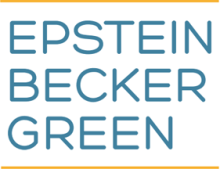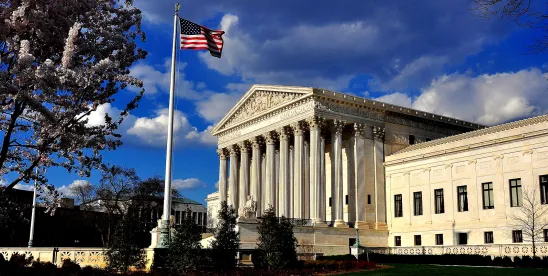As this term draws to a close, the U.S. Supreme Court is getting busy in reducing its inventory of pending cases. Yesterday, six of them were resolved.
Unfortunately for me, as well as other lawyers who frequently deal with class actions, the case I was most eagerly awaiting, Laboratory Corporation of America Holdings v. Davis, was resolved summarily with a one-liner indicating a “DIG,” that is, “cert. dismissed as improvidently granted.”
Usefully for us interested lawyers, though, Justice Kavanaugh dissented from this per curiam decision, and his dissenting opinion gives us a good idea of what the other eight Justices were thinking and how the issue in the case might come up again in future terms.
The question presented was whether a federal court may certify a damages class pursuant to Federal Rule of Civil Procedure 23 (“Rule 23”) when the class includes both injured and uninjured members. The underlying case was simple: various blind and visually impaired individuals alleged that Labcorp had violated the Americans with Disabilities Act and a state analog with respect to the accessibility of touchscreen kiosks by which patients can check in for their medical appointments. The class that these individuals sought to represent contained persons who, though legally blind, either would not use the kiosks at all or were indeed unable to use them. Nevertheless, the U.S. Court of Appeals for the Ninth Circuit ultimately approved the class, notwithstanding that it “potentially includes more than a de minimis number of uninjured class members.”
Justice Kavanaugh believes that the Court “digged” the case because it was unwilling to wade into the threshold issue of mootness. He would have done so and held that a Rule 23 damages class cannot include uninjured members. To be fair, the majority very well might have been motivated by the doctrine of avoidance, but for those of us involved in securities and employment litigation and, more recently, cybersecurity and data privacy cases, this issue of inclusion in classes of uninjured persons is very much live. This is a bad news / good news issue, however: Bad in the sense that a lively issue will not be decided, at least at present, good in the sense that it is likely to recur. At that point, we know at minimum how Justice Kavanaugh will vote.
Now, let’s turn to the cases that actually were decided on the merits.
On behalf of a unanimous Court in Ames v. Ohio Dept. of Youth Services, Justice Jackson wrote that the Sixth Circuit’s “background circumstances” rule—which requires members of a majority group to satisfy a heightened evidentiary standard to prevail on a claim under Title VII, 42 U. S. C. §2000e– 2(a)(1)—“cannot be squared with the text of Title VII or the Court’s precedents.” Most of this blog’s readers understand that Title VII’s disparate-treatment provision bars employers from intentionally discriminating against their employees on the basis of race, color, religion, sex, or national origin. It is usually “not onerous” for a plaintiff to state a prima facie case of discrimination, but the “background circumstances” rule requires plaintiffs who are members of a majority group to bear an additional burden at the outset of a disparate impact, reverse discrimination case. “The question in this case is whether, to satisfy [its] prima facie burden, a plaintiff who is a member of a majority group must also show ‘background circumstances to support the suspicion that the defendant is that unusual employer who discriminates against the majority.’”
The Court answers that question in the negative, holding that the “background circumstances” requirement “is not consistent with Title VII’s text or our case law construing the statute.” In doing so, the Court recognized that Title VII’s pleading requirements are the same whether the plaintiffs are members of minority or majority groups. The statute bars discrimination against “any individual,” not groups, because of protected characteristics. “Congress left no room for courts to impose special requirements on majority-group plaintiffs alone.” The Court thus reversed the case and remanded it for further proceedings under a uniform pleading standard.
Interestingly, Justice Thomas, joined by Justice Gorsuch, wrote a separate concurring opinion decrying “the problems that arise when judges create atextual legal rules and frameworks.” Pending cases in other areas of the law, especially where a spate of recent executive orders is at issue, will likely confront certain Justices with the adage about “what is sauce for the goose is sauce to the gander.” One would not be surprised if, say, Justice Kagan were to remind her concurring colleagues of that observation in future cases where textual literalness might be questioned. For the present, employment law practitioners should take note of the Ames case in a litigation environment increasingly rich in reverse discrimination cases spawned by executive orders banning diversity, equity, and inclusion or similar programs.
Smith & Wesson Brands, Inc. v. Estados Unidos Mexicanos is another case decided by a unanimous Court. The decision was written by Justice Kagan, with the odd couple of Justices Thomas and Jackson also separately concurring. The case arose with a lawsuit filed by the government of Mexico against seven American gun manufacturers, claiming that the companies aided and abetted unlawful sales of guns that were routed to Mexican drug cartels. The suit was premised on the theory that the manufacturers failed to exercise “reasonable care.” The Protection of Lawful Commerce in Arms Act (PLCAA) provides that a “qualified civil liability action . . . may not be brought in any Federal or State court,” against a firearms manufacturer or seller stemming from “the criminal or unlawful misuse” of a firearm by “a third party,” §7903(5)(A).
But there is a “predicate exception” to this protective language, applying in cases where a defendant manufacturer or seller “knowingly violated a State or Federal statute applicable to the sale or marketing” of firearms, and the “violation was a proximate cause of the harm for which relief is sought.” §7903(5)(A)(iii). “The predicate violation PLCAA demands may come from aiding and abetting someone else’s firearms offense. PLCAA itself lists as examples two ways in which aiding and abetting qualifies—when a gun manufacturer (or seller) aids and abets another person in making a false statement about a gun sale’s legality or in making specified criminal sales.” This exception derives from the federal law that whoever “aids [and] abets” a federal crime “is punishable as a principal.” See 18 U. S. C. §2(a).
Although Mexico’s complaint was rife with details concerning the companies’ lack of downstream controls over the distribution of the firearms that they produce, including selling guns to distributors whom they know deal with Mexican drug traffickers, it did not pinpoint any particular criminal transactions in which the defendants allegedly assisted and otherwise spoke in general terms more to what the defendants might have known than what they actually did or didn’t do. Thus, the Court, per Justice Kagan, held that the complaint was implausible, a conclusion that “aligns with PLCAA’s core purpose. Congress enacted PLCAA to halt lawsuits attempting to make gun manufacturers pay for harms resulting from the criminal or unlawful misuse of firearms. Mexico’s suit closely resembles those lawsuits. And while the predicate exception allows some such suits to proceed, accepting Mexico’s theory would swallow most of the rule. The Court doubts Congress intended to draft such a capacious way out of PLCAA, and in fact it did not.” The judgment below, therefore, was reversed and the case remanded.
Catholic Charities Bureau, Inc. v. Wisconsin Labor and Industry Review Commission is yet another case in which the Court was unanimous. And again, Justice Thomas and Justice Jackson filed concurring opinions. The issue before the Court derived from a Wisconsin law that exempts certain nonprofit religious organizations from paying unemployment compensation taxes. The exempted organizations must be “operated primarily for religious purposes” and be “operated, supervised, controlled, or principally supported by a church or convention or association of churches.” Catholic Charities and four of its subsidiaries controlled by the Roman Catholic Diocese of Superior, Wisconsin, sought and were denied the exemption on the ground they were not “operated primarily for religious purposes” because they neither engaged in proselytization nor limited their charitable services to Catholics.” The Supreme Court, per Justice Sotomayor, held that the Wisconsin Supreme Court’s interpretation violated the First Amendment, which “mandates government neutrality between religions and subjects any state-sponsored denominational preference to strict scrutiny.” Justice Sotomayor writes that the Wisconsin Supreme Court imposes an improper denominational preference by differentiating between religions based on theological lines. The petitioners’ eligibility for the exemption comes from inherently religious choices such as whether to proselytize or serve only fellow Catholics, “not ‘“secular criteria”’ that ‘happen to have a “disparate impact” upon different religious organizations.’” Because that regime explicitly differentiates between religions based on theological practices, strict scrutiny applies, and Wisconsin failed it.
The Court’s unanimity, with Justices Thomas and Jackson expanding upon what the Court as a whole was willing to endorse, is not surprising. But it does open the door to future cases that deal with controversial secular issues, such as reproductive rights, gender, etc., in which church-sponsored entities are involved. This Wisconsin case, significant in itself, might be no more than a piece in a large construction still under development.
Yesterday’s “kumbaya” moment continued with a unanimous decision in CC/Devas (Mauritius LD.) v. Antrix Corp. The matter originated in a breach of contract suit between an entity owned by the government of India and a satellite leasing company that terminated a contract when India demanded increases in capacity that the company rejected, defending its position based on force majeure. Under the Foreign Sovereign Immunities Act of 1976 (FSIA), personal jurisdiction exists when an immunity exception applies and service is proper.
However, reversing the Ninth Circuit (no surprise there), the Supreme Court held that FSIA does not require proof of “minimum contacts” over and above the contacts already required by the FSIA’s enumerated exceptions to foreign sovereign immunity. The law determines when the district court has subject-matter jurisdiction, which the FSIA grants whenever an enumerated immunity exception applies, and service must have been made under FSIA’s rules. “When both criteria are satisfied,” the Court writes, “personal jurisdiction ‘shall exist.’ Accordingly, the most natural reading of the operative text is that personal jurisdiction over a foreign sovereign is automatic whenever an immunity exception applies and service of process has been accomplished. Notably absent from the provision is any reference to ‘minimum contacts.’ And the Court declines to add what Congress left out, as the FSIA was supposed to ‘clarify the governing standards,’ not hide the ball.”
This was another day when, as Justice Kagan has in the past suggested of her colleagues and herself, as regards textualism, “we are all colleagues now.”
The Court was also essentially unified in its decision in Blom Bank Sal v. Honickman. Analysis of this case sends us back to federal procedure class in law school, covering the application of Fed. R. Civ. P. 60(b)(6) concerning vacating a final judgment and whether its extraordinary circumstances standard must be tempered by Rule 15(a)’s liberal amendment policy. Here, the plaintiffs were the victims and victims’ families of Hamas attacks in the early 2000s. They claimed that Blom Bank aided and abetted violations of the Anti-Terrorism Act by providing financial services to customers affiliated with Hamas.
The district court dismissed the case with prejudice, finding that the plaintiffs had failed to allege that the bank had sufficient awareness to support aiding and abetting liability. The plaintiffs had stated repeatedly that they would not seek to amend their complaint if it were dismissed. Nevertheless, they decided to so move following dismissal, but the district court denied leave to amend because the plaintiffs, having declined several previous opportunities to amend their complaint, also failed to identify additional facts that could be alleged if leave were granted. That ruling was affirmed by the Second Circuit, but the plaintiffs did not quit. They went back to the district court with a Rule 60(b)(6) motion seeking to vacate the judgment and then amend the complaint to conform with the standards described by the Second Circuit.
While that stratagem failed in the district court, it succeeded in the Court of Appeals, which held that the consideration of 60(b)(6) relief should have been tempered by balancing its severity with the lenience of the relaxed standards of Rule 15. None of the Supreme Court Justices bought that. Instead, the Court held that the extraordinary circumstances required for vacating a judgment under Rule 60(b)(6) do not become less demanding when a party invokes Rule 15(a)’s lenient standard for amendment. Again, looking to text, the Court concluded that, while Rule 15 might be applied liberally in pretrial proceedings, it’s a different story following judgment. Then, a party must demonstrate extraordinary circumstances regarding what they claim they would do if the case were reopened. The balancing test that the plaintiffs sought is incompatible with the text and with a long line of Second Circuit decisions.
A big day ended with a series of unrelated cases having been decided, but with many of them offering very useful guidance in the prosecution and defense of litigation. Summer is coming, and the decisions ending the term are flowing. Six in a day is plenty.




 />i
/>i
